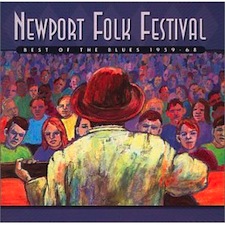It’s the time of year for saving money!
 Before there was Farm Aid, Telluride, or even Woodstock,
Before there was Farm Aid, Telluride, or even Woodstock,
there was the Newport Folk Festival. Begun in the late fifties, this yearly gathering
molded and defined a generation’s tastes in music. It was the all-star event of
roots music. This pair of Vanguard three CD sets, one for blues and one for
bluegrass, let us hear what some of the greats sounded like when they were on
top of their game.
The Bluegrass box features Hylo Brown and the Timberliners,
The Stanley Brothers with the Clinch Mountain Boys, Lester Flatt and Earl
Scruggs and the Foggy Mountain Boys, Jim and Jesse and the Virginia Boys, Don
Stover, The Lilly Brothers with Don Stover and Tex Logan, Hazel Dickens and
Alice Gerrard, and the father of Bluegrass, Bill Monroe. The Bluegrass Boys
performed behind Bill for this 1965 set included Peter Rowan on guitar and lead
vocals, Tex Logan on fiddle, Don Lineberger on banjo, and James Monroe on
string bass. While some of the material on this album has been previously
released, sixteen tracks that have never before seen the light of day. Since
bluegrass is primarily ensemble music that makes extensive use of
improvisation, studio albums, especially from the mid-60’s, rarely capture the
true spirit of the music. These Newport performances offer us a priceless
glimpse of what these bluegrass pioneers could do when playing live before an
appreciative audience.
Best of the Blues 1959 – 1968 has three CD’s, each with a
different title. “Delta Blues” contains performances by Mississippi
John Hurt, Skip James, Son House, Bukka White, Mississippi Fred McDowell, and
Muddy Waters doing his solo act. “Country Blues” features Robert Pete
Williams, Mance Lipsomb, Jesse Fuller, Reverand Gary Davis, Brownie McGhee and
Sonny Terry, and Sleepy John Estes. “Urban Blues” serves up Lightnin’
Hopkins, John Lee Hooker, Memphis Slim, Muddy Waters with Otis Spann, the
Chambers Brothers (pre-“Time Has Come Today”), and Paul Butterfield’s
Blues Band with Mike Bloomfield on lead guitar. Twelve previously unreleased
tracks are peppered throughout these CD’s.
Since so few of these original “first-generation”
blues players are still with us today, the only way to find out what they
sounded like is through recordings. What is most remarkable is not how
“primitive” or “funky” they are, but how sophisticated
their guitar work is. Listen to John Hurt on “Stagolee”, or Mance
Lipscomb doing “God Moves on the Water”. These guys were nothing
short of amazing.
Tom Vickers, who produced the Blues CD, and Fred Jasper, who
handled the Bluegrass CD, are to be commended not only for the overall
packages, but the fine attention to detail throughout. The album notes on these
CDs are both entertaining and informative. Two different mastering engineers,
David Glasser for the bluegrass, and Jeff Zaraya for the blues, managed to
preserve all the fidelity available from the original analog tapes. I
especially liked the fact that they retained all the low-frequency information
such as footfalls and stomps that helps to make the music vibrant.
If you are a serious fan of either bluegrass or blues you
can’t consider your collection to be anywhere near complete without these CD’s.
They are as essential as air or water.





